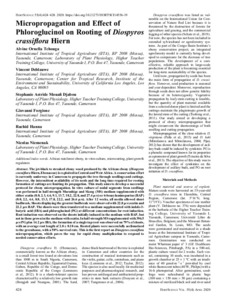| dc.contributor.author | Tchouga, A.O. |
| dc.contributor.author | Deblauwe, V. |
| dc.contributor.author | Djabou, S.A.M. |
| dc.contributor.author | Forgione, G. |
| dc.contributor.author | Hanna, R. |
| dc.contributor.author | Niemenak, N. |
| dc.date.accessioned | 2022-04-25T10:18:04Z |
| dc.date.available | 2022-04-25T10:18:04Z |
| dc.date.issued | 2020-04 |
| dc.identifier.citation | Tchouga, A.O., Deblauwe, V., Djabou, S.A.M., Forgione, G., Hanna, R. & Niemenak, N. (2020). Micropropagation and effect of phloroglucinol on rooting of Diospyros crassiflora Hiern. HortScience, 55(4), 424-428. |
| dc.identifier.issn | 0018-5345 |
| dc.identifier.uri | https://hdl.handle.net/20.500.12478/7434 |
| dc.description.abstract | The jet-black to streaked ebony wood produced by the African ebony (Diospyros crassiflora Hiern, Ebenaceae) is exploited in Central and West Africa. A conservation effort is currently underway in Cameroon to propagate the tree through seedlings and cuttings. However, the intermittent availability of its seeds and the long time required for rooting formation of cuttings are limiting its propagation. This study aims to develop a successful protocol for ebony micropropagation. In vitro culture of nodal segments from seedlings was performed in half-strength Murashige and Skoog (MS) medium supplemented with either zeatin (0.0, 2.3, 4.6, 9.1, 13.7, 18.2, 22.8, and 27.4 µm) or 6-benzylaminopurine (BAP) (0.0, 2.2, 4.4, 8.8, 13.3, 17.8, 22.2, and 26.6 µm). After 12 weeks, all media allowed shoot budbreak. Shoots displaying the greatest budbreak were observed with 22.8 µm zeatin and 22.2 µm BAP. The shoots were then transferred to a medium supplemented with indole-3-butyric acid (IBA) and phloroglucinol (PG) at different concentrations for root induction. Root induction was observed on the shoots initially induced in the medium with BAP, but not in those grown in the medium with zeatin. In half-strength MS supplemented with 396.5 µm PG plus 14.2 µm IBA, the formation of a single tap root was observed on 79% of shoots, with an average root length of 2.8 ± 0.18 cm. Rooted plants were successfully acclimatized to the greenhouse, with a 50% survival rate. This is the first report on Diospyros crassiflora micropropagation, which paves the way for rapid ebony multiplication to respond to needed conservation efforts. |
| dc.format.extent | 424-428 |
| dc.language.iso | en |
| dc.subject | In Vitro Culture |
| dc.subject | Microcuttings |
| dc.subject | Plant Growth Substances |
| dc.subject | Micropropagation |
| dc.title | Micropropagation and effect of phloroglucinol on rooting of Diospyros crassiflora Hiern |
| dc.type | Journal Article |
| cg.contributor.affiliation | International Institute of Tropical Agriculture |
| cg.contributor.affiliation | University of Yaoundé |
| cg.coverage.region | Africa |
| cg.coverage.region | Central Africa |
| cg.coverage.country | Cameroon |
| cg.coverage.hub | Central Africa Hub |
| cg.researchtheme | Natural Resource Management |
| cg.identifier.bibtexciteid | TCHOUGA:2020 |
| cg.isijournal | ISI Journal |
| cg.authorship.types | CGIAR and developing country institute |
| cg.iitasubject | Agronomy |
| cg.iitasubject | Forestry |
| cg.iitasubject | Natural Resource Management |
| cg.iitasubject | Plant Production |
| cg.journal | HortScience |
| cg.notes | Open Access Journal; Published online: 05 Mar 2020 |
| cg.accessibilitystatus | Open Access |
| cg.reviewstatus | Peer Review |
| cg.usagerightslicense | Creative Commons Attribution-NonCommercial-NoDerivatives No Version (CC BY-NC-ND) |
| cg.targetaudience | Scientists |
| cg.identifier.doi | https://dx.doi.org/10.21273/hortsci14556-19 |
| cg.iitaauthor.identifier | Vincent Deblauwe: 0000-0001-9881-1052 |
| cg.iitaauthor.identifier | Rachid Hanna: 0000-0002-5715-0144 |
| cg.futureupdate.required | No |
| cg.identifier.issue | 4 |
| cg.identifier.volume | 55 |

